Located in central Budapest, Liberty Square is far more than a public plaza, it is a layered landscape of monuments and historic buildings that reflect Hungary’s turbulent past and evolving identity. From politically charged memorials to striking architectural landmarks, the square offers a compelling narrative in stone and bronze. This article explores the statues and structures that define Liberty Square, revealing the stories they tell about war, power, memory, and national transformation.
Ronald Reagan Statue
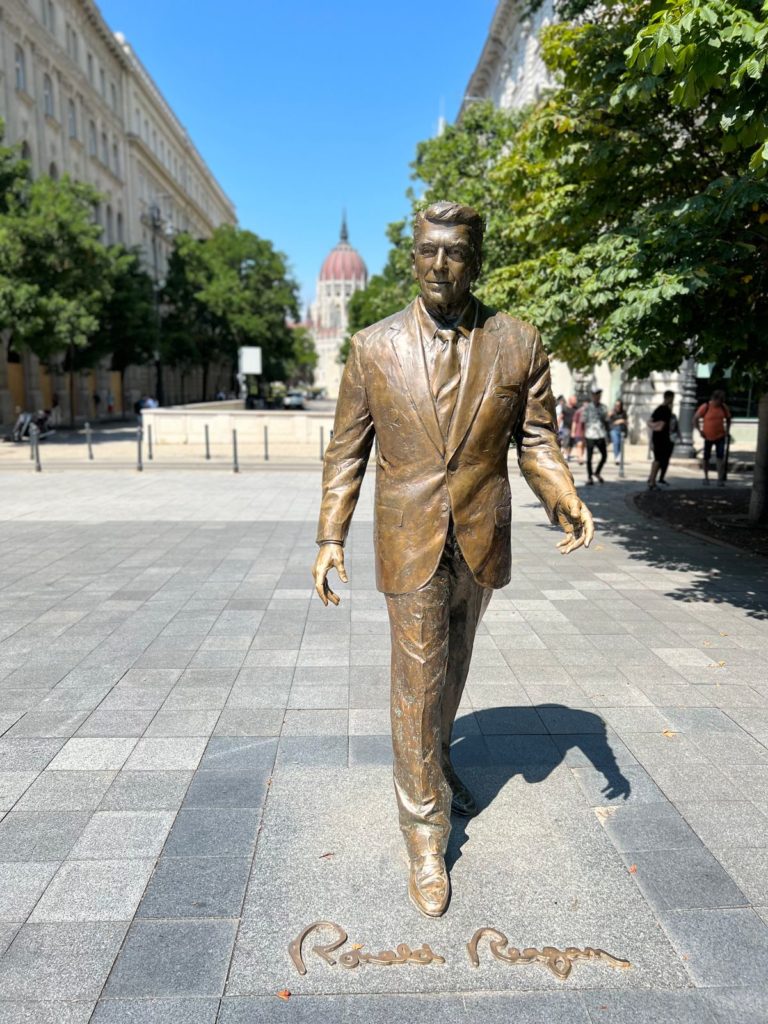
Honoring a Cold War Architect
In June 2011, a seven-foot bronze statue of Ronald Reagan was unveiled in Budapest’s Liberty Square, commemorating the 100th anniversary of his birth. Though Reagan never visited Hungary, his leadership during the Cold War is credited with aiding the country’s liberation from Soviet influence. Hungarian Prime Minister Viktor Orbán emphasized Reagan’s role in “creating a new world for Central Europe” by supporting the dismantling of communist regimes.
Symbolic Placement and Design
The statue, crafted by Hungarian sculptor István Máté, depicts Reagan mid-stride, facing the U.S. Embassy. Notably, it also aligns with a Soviet war memorial within the square, creating a juxtaposition between symbols of liberation and former oppression. This placement underscores Hungary’s complex historical narrative and its appreciation for international support in achieving sovereignty.
Interestingly, the statue’s positioning suggests Reagan is walking away from the nearby Hungarian Parliament building, as if symbolically returning from a visit. This orientation adds another layer of meaning, highlighting the connection between Hungary’s legislative body and the democratic ideals that Reagan championed
A Site of Political Memory
Liberty Square has long been a focal point for Hungary’s political history, housing monuments that reflect various eras and ideologies. The addition of Reagan’s statue contributes to this tapestry, serving as a reminder of the international alliances that supported Hungary’s transition to democracy. It stands as a testament to the enduring relationship between Hungary and the United States, rooted in shared values of freedom and democracy.
Soviet War Memorial
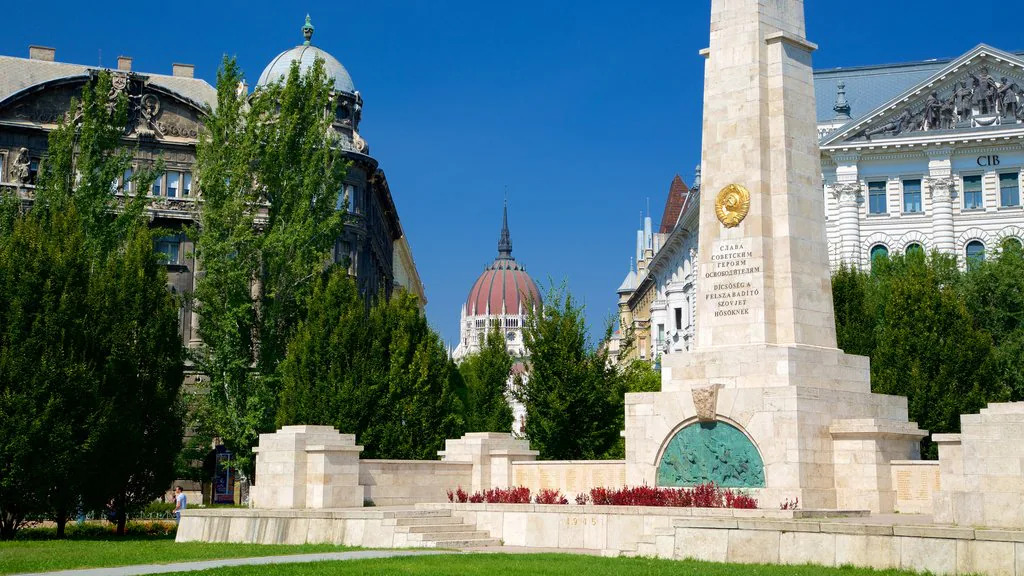
A Monument to Sacrifice and Victory
At the northern end of Liberty Square stands one of the most debated monuments in Budapest: the Soviet War Memorial. Built in 1945, it was designed to honor the soldiers of the Red Army who died during the liberation of Hungary from Nazi occupation in World War II. The monument consists of a tall stone obelisk crowned with a golden star and engraved with both Russian and Hungarian inscriptions praising the Soviet “heroes.” Bas-relief sculptures depict Soviet troops in combat, symbolizing their victory and sacrifice in the Battle of Budapest.
Although it was intended as a tribute to liberation, the monument’s meaning became more complicated in the years that followed. For many Hungarians, the Soviet presence did not end with freedom from Nazi rule—it marked the beginning of nearly half a century of Soviet control. As a result, what was once celebrated as a symbol of rescue became, for some, a reminder of foreign domination and the loss of national sovereignty. The memorial’s location in Liberty Square, close to tributes to Western leaders like Ronald Reagan, emphasizes the ideological contrast between liberation and occupation, freedom and repression.
Memory, Diplomacy, and Historical Complexity
Despite the controversy, the monument remains in place. It is one of the few Soviet-era memorials that survived the post-communist transition in Hungary. Its continued presence is influenced not only by its historical significance but also by diplomatic considerations, particularly in regard to Hungary’s relations with Russia. The memorial often becomes a point of tension in debates about public space, history, and identity, especially in a square so rich in political symbolism.
The Soviet War Memorial today reflects the layered and often conflicting interpretations of Hungary’s 20th-century past. It stands both as a record of military sacrifice and as a prompt for ongoing dialogue about historical memory. Its endurance is not simply an act of preservation but a recognition of the complexities involved in reconciling gratitude for liberation with the reality of decades of political repression.
Memorial to the Victims of the German Occupation
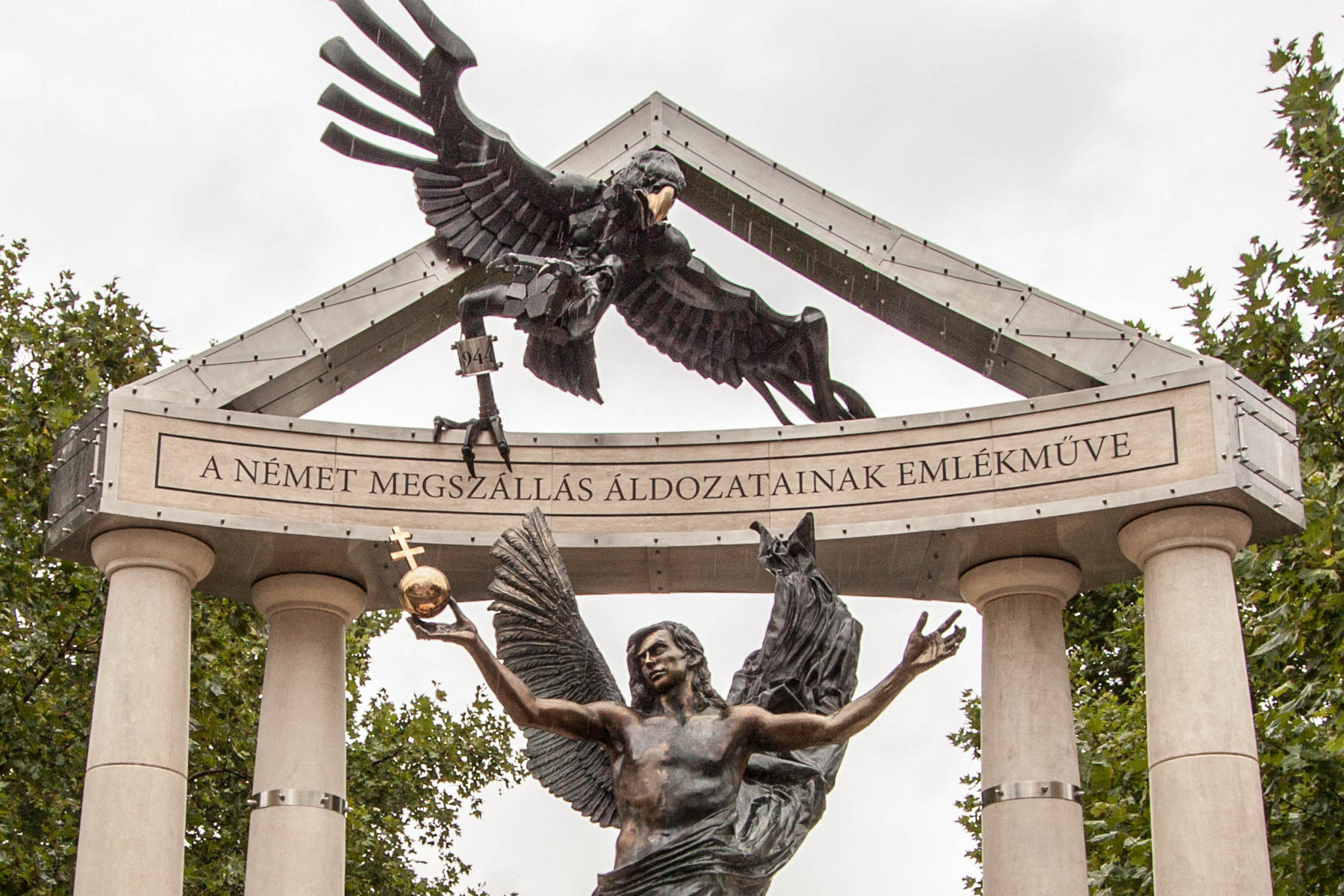
Symbolism and Design
Located at the southern end of Liberty Square, the Memorial to the Victims of the German Occupation was unveiled in July 2014. The monument features the Archangel Gabriel, representing Hungary, holding the globus cruciger—a symbol of Hungarian sovereignty. An eagle, symbolizing Nazi Germany, descends upon the angel with outstretched claws, bearing the date “1944” on its ankle, marking the year of the German occupation of Hungary. The inscription at the base reads “In memory of the victims.” The monument’s design has been interpreted as portraying Hungary as an innocent victim of Nazi aggression, a perspective that has sparked significant controversy.
Public Response and the Living Memorial
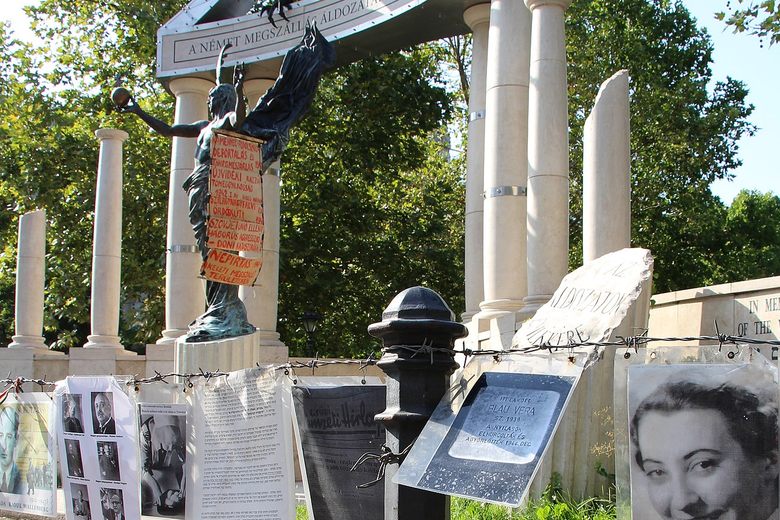
The memorial has been met with widespread criticism, particularly from Jewish communities and historians, who argue that it attempts to absolve Hungary of its role in the Holocaust. Critics contend that the monument overlooks the Hungarian government’s collaboration with Nazi Germany and the deportation of over 400,000 Hungarian Jews in 1944.
In response to the official memorial, a grassroots initiative known as the “Living Memorial” emerged. This counter-memorial consists of personal artifacts, photographs, and written accounts left by individuals to honor the memory of Holocaust victims and to challenge the narrative presented by the official monument. The Living Memorial serves as a poignant reminder of the complexities of history and the importance of acknowledging all facets of the past.
Together, the official memorial and the Living Memorial encapsulate the ongoing debates in Hungary regarding historical memory, responsibility, and the portrayal of national history.
Statue of General Harry Hill Bandholtz
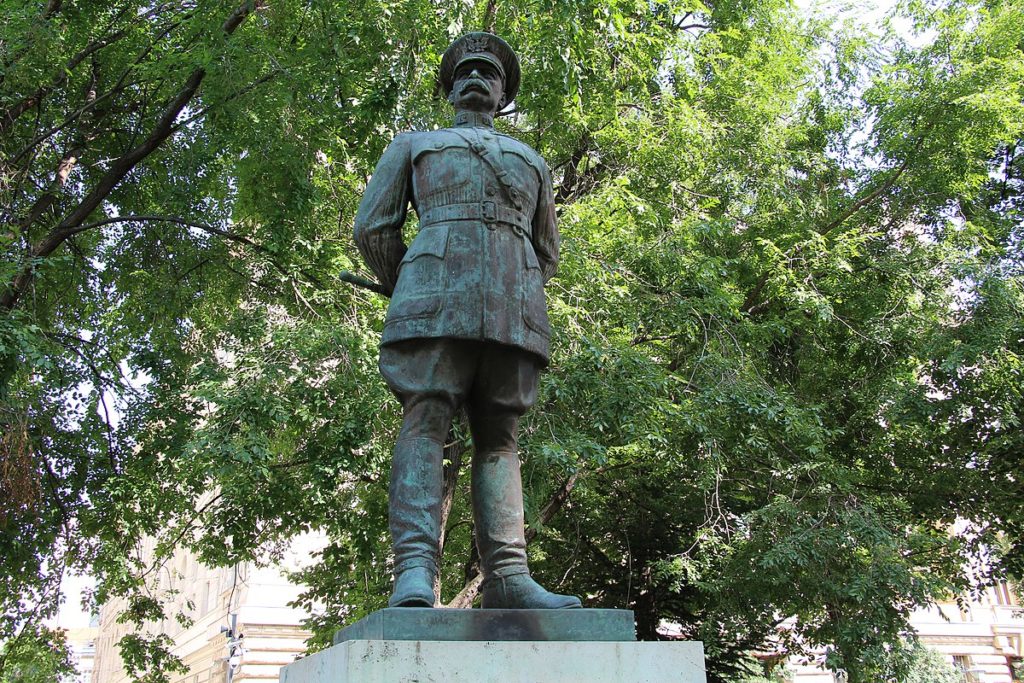
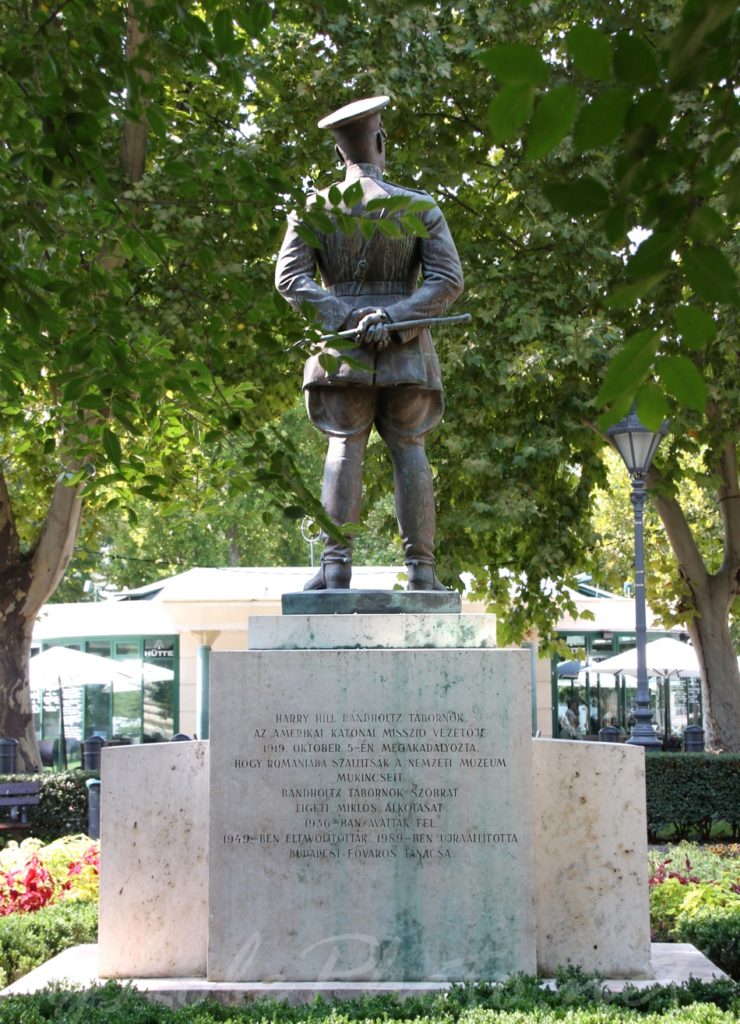
In the aftermath of World War I, Hungary found itself in a tumultuous period marked by foreign occupations and internal strife. Amid this chaos, Brigadier General Harry Hill Bandholtz of the United States Army played a pivotal role in preserving Hungary’s cultural treasures. As the U.S. representative to the Inter-Allied Military Mission in Hungary in 1919, Bandholtz was tasked with overseeing the withdrawal of Romanian troops from Hungarian territory.
On October 5, 1919, Bandholtz confronted Romanian soldiers attempting to seize artifacts from the Hungarian National Museum under the pretext of reclaiming cultural property. Armed only with his riding crop, Bandholtz stood his ground and prevented the looting. He sealed the museum’s doors and took the keys, returning them weeks later after the Romanian forces had withdrawn. This act of courage and diplomacy earned him lasting gratitude from the Hungarian people.
Commemoration and Controversy
To honor his actions, a statue of General Bandholtz was erected in 1936 in Budapest’s Liberty Square, sculpted by Miklós Ligeti. The statue depicts Bandholtz in uniform, holding his iconic riding crop behind his back—a symbol of his peaceful yet firm intervention. The inscription on the statue reads: “I simply carried out the instructions of my government, as I understood them, as an officer and a gentleman of the United States Army.”
However, the statue’s presence has not been without controversy. Romanian authorities objected to its depiction, viewing it as a misrepresentation of historical events. In response to these objections, the statue was removed during Hungary’s communist era under the guise of restoration. It was stored away for decades, symbolizing the shifting political landscapes and narratives of the time.
Restoration and Legacy
In 1989, as Hungary moved towards democratic reforms, the statue was reinstated in its original location in Liberty Square, just days before a visit from U.S. President George H. W. Bush. This restoration was seen as a reaffirmation of Hungary’s appreciation for Bandholtz’s contributions and a gesture of renewed U.S.-Hungarian relations.
Today, the statue stands not only as a tribute to a foreign general who protected Hungary’s cultural heritage but also as a symbol of the enduring values of courage, diplomacy, and international cooperation. It continues to be a point of reflection on the complexities of history and the individuals who shape it.
Memorial to the Revolutionaries of 1848
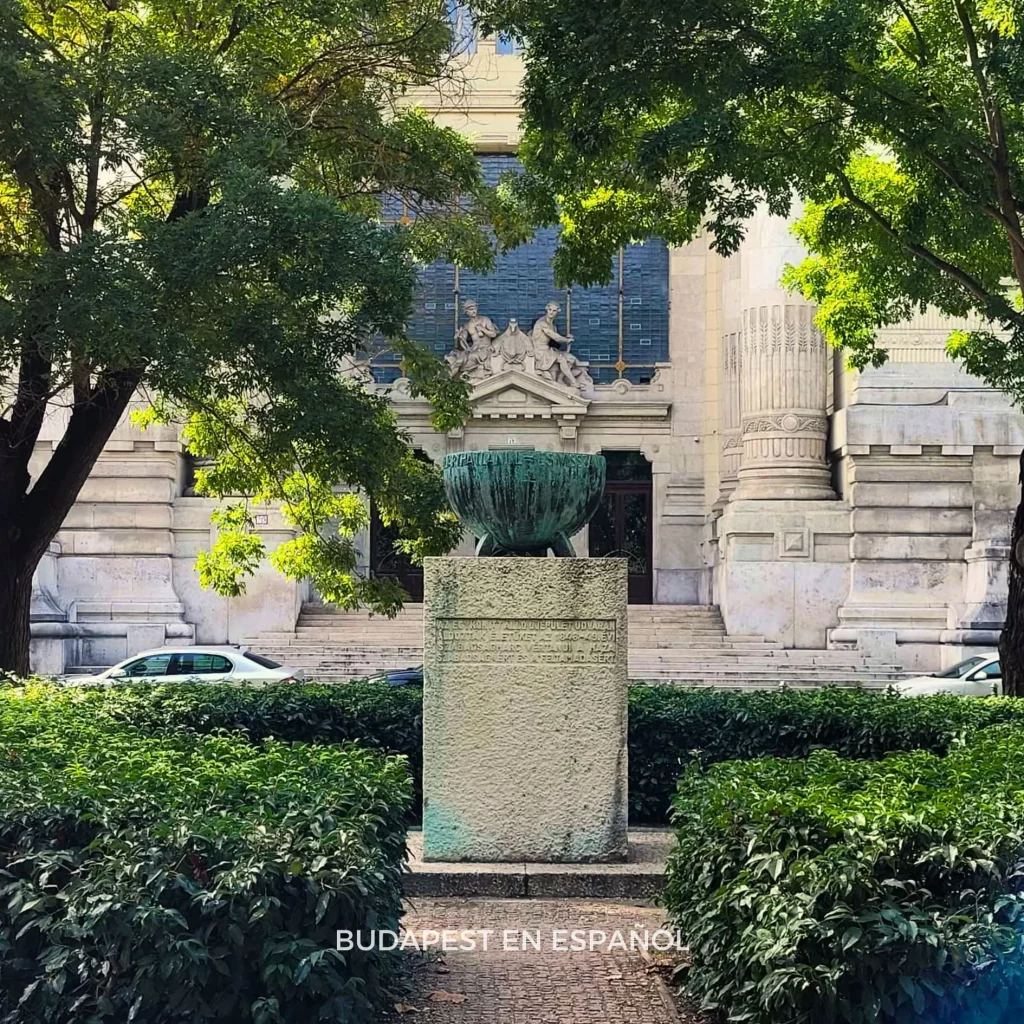
Historical Significance and Location
Situated in Szabadság tér (Liberty Square) in Budapest, the Memorial to the Revolutionaries of 1848 commemorates the Hungarian Revolution of 1848, a pivotal uprising against Habsburg rule. This revolution was part of a series of interconnected movements across Europe advocating for national independence and democratic reforms. The memorial serves as a tribute to the individuals who fought for Hungary’s sovereignty and the establishment of a modern, democratic state.
The location of the memorial is historically significant. Liberty Square was once the site of the “Újépület” (New Building), a barracks and prison where Prime Minister Lajos Batthyány was executed in 1849 following the revolution. The building was demolished in 1897, and the square was established to honor the memory of those who sacrificed their lives for Hungary’s independence.
Design and Symbolism
The memorial features a striking sculpture that encapsulates the spirit of resistance and the quest for freedom. Its artistic design reflects the passion and determination of the revolutionaries, serving both as a tribute and a reminder of the sacrifices made for the country’s liberty. Visitors can engage with the memorial by reading the plaques and inscriptions that provide deeper insight into its historical context.
Hungarian National Bank
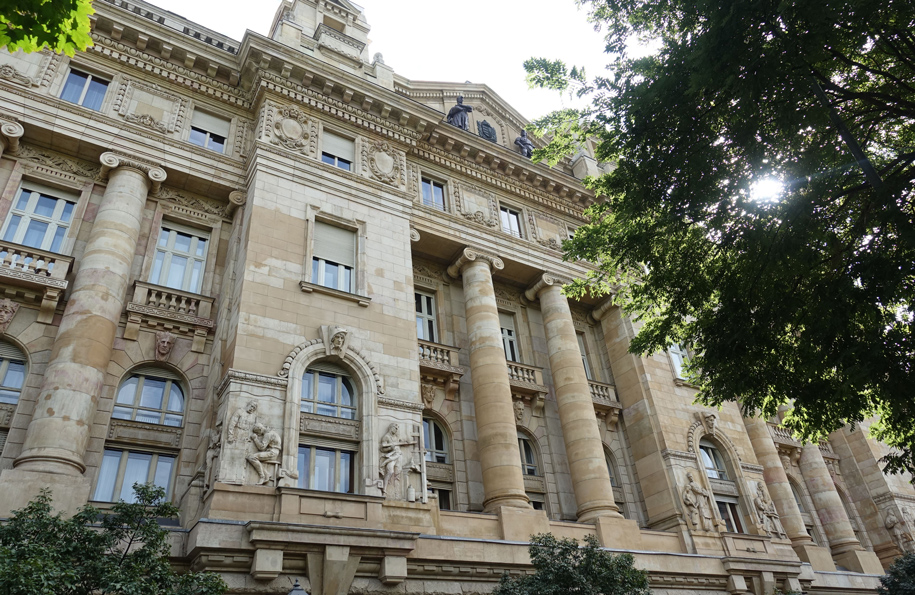
Origins and Architectural Significance
Dominating the eastern side of Liberty Square, the headquarters of the Hungarian National Bank (Magyar Nemzeti Bank, MNB) stands as a testament to early 20th-century architectural ambition and Hungary’s financial evolution. Constructed between 1902 and 1905, the building was originally designed to serve as the Budapest branch of the Austro-Hungarian Bank. Renowned Hungarian architect Ignác Alpár envisioned the structure in a historicizing, neo-baroque style, complemented by intricate limestone reliefs crafted by sculptor Károly Sennyei. These artistic elements depict themes of commerce, industry, and prosperity, reflecting the building’s financial purpose.
The building’s exterior is adorned with allegorical sculptures and decorative motifs that symbolize economic strength and national identity. Its grand façade and imposing presence contribute to the architectural harmony of Liberty Square, aligning with other monumental structures in the vicinity. The design not only served functional needs but also projected the stability and authority of the financial institution it housed.
Evolution into the Central Bank
Following the dissolution of the Austro-Hungarian Empire after World War I, Hungary established its independent central bank in 1924, utilizing this building as its headquarters. The Magyar Nemzeti Bank has since played a pivotal role in the nation’s economic development, overseeing monetary policy, issuing currency, and maintaining financial stability. Throughout its history, the bank has navigated various economic challenges, including periods of inflation, currency reform, and integration into the European financial system.
The building itself has witnessed significant historical events and transformations. During World War II and the subsequent communist era, modifications were made to its interior and exterior, some of which altered or obscured original architectural details. Despite these changes, the structure remained a central figure in Hungary’s financial landscape, symbolizing continuity amidst political and economic shifts.
Restoration and Contemporary Role
In recent years, efforts have been undertaken to restore the Hungarian National Bank’s headquarters to its original splendor. Renovations aim to preserve the building’s historical and architectural integrity while updating its facilities to meet modern standards. These restoration projects underscore a commitment to honoring Hungary’s cultural heritage and the enduring significance of the institution within the national consciousness.
Today, the Hungarian National Bank continues to function as the country’s central financial authority, operating from this iconic building. Its presence in Liberty Square not only serves practical purposes but also stands as a monument to Hungary’s economic history and architectural achievement. The building remains a point of interest for visitors and locals alike, embodying the intersection of finance, history, and art in the heart of Budapest
U.S. Embassy in Budapest
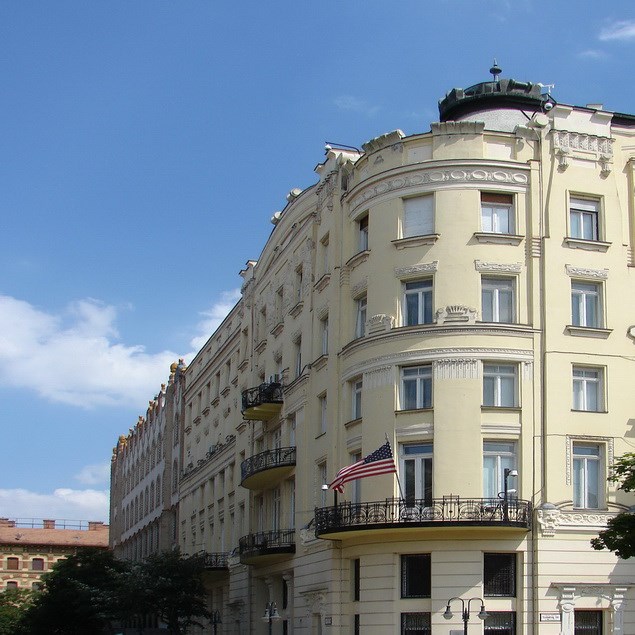
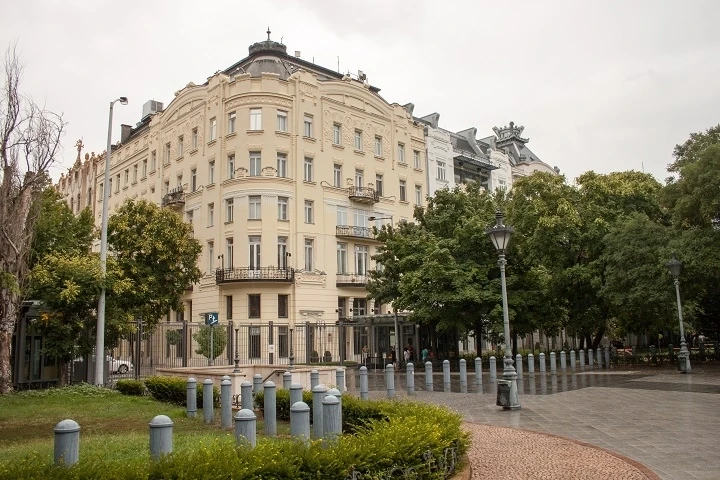
Architectural Heritage and Location
Situated at 12 Liberty Square in Budapest’s Fifth District, the U.S. Embassy occupies a building originally constructed in 1901 as the Hungarian Hall of Commerce. Designed by architects Aladár Kármán and Gyula Ullman, the structure exemplifies the Secessionist style, a variant of Art Nouveau prominent in Central Europe during the early 20th century. The building’s ornate façade and intricate detailing contribute to the architectural diversity of Liberty Square, which features a blend of historicist and Art Nouveau designs.
The embassy’s location in Liberty Square places it amidst significant monuments and institutions, including the Hungarian National Bank and various memorials commemorating pivotal events in Hungarian history. This setting underscores the embassy’s role not only in diplomatic affairs but also in the cultural and historical tapestry of Budapest.
Historical Significance and Diplomatic Role
The United States established its diplomatic mission in Hungary on December 26, 1921, initially operating from a different location before relocating to the current building in Liberty Square on January 20, 1934. The embassy has since served as the primary conduit for U.S.-Hungarian relations, navigating periods of both cooperation and tension throughout the 20th and 21st centuries.
During World War II, the embassy building played a crucial role in humanitarian efforts. Swiss Vice-Consul Carl Lutz operated from the U.S. Legation, utilizing diplomatic protections to establish safe houses that sheltered over 62,000 Hungarian Jews from deportation. A memorial honoring Lutz’s courageous actions was unveiled in 2006 in a park adjacent to the embassy, serving as a testament to the building’s historical significance beyond its diplomatic functions.
In the Cold War era, the embassy became a focal point during the 1956 Hungarian Revolution. Cardinal József Mindszenty sought asylum within the embassy, residing there for nearly 15 years to avoid arrest by the communist regime. This period highlighted the embassy’s role as a sanctuary and symbol of U.S. support for Hungarian dissidents.
Contemporary Presence and Symbolism
Today, the U.S. Embassy continues to function as the epicenter of American diplomatic activities in Hungary, fostering bilateral relations encompassing political, economic, and cultural dimensions. The embassy’s presence in Liberty Square, surrounded by monuments reflecting Hungary’s complex history, symbolizes the enduring partnership between the United States and Hungary.
The embassy’s proximity to statues of American figures such as Ronald Reagan and George H. W. Bush further emphasizes the shared values and historical ties between the two nations. These monuments, along with the embassy itself, contribute to Liberty Square’s role as a space of remembrance, dialogue, and international connection.
Former Budapest Stock Exchange Building
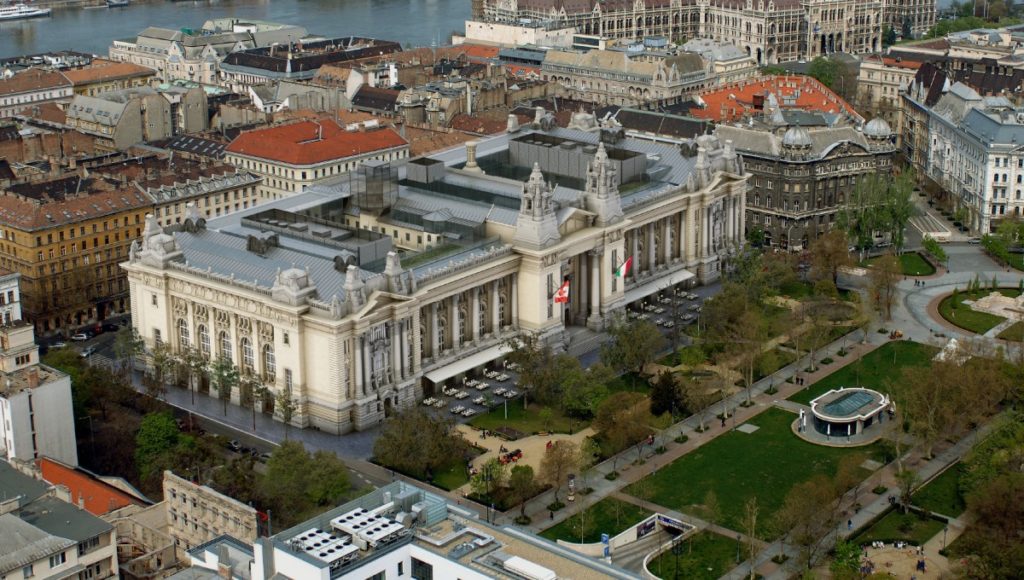
Architectural Grandeur and Historical Role
Occupying a prominent position on the western side of Liberty Square, the former Budapest Stock Exchange Building, also known as the Exchange Palace (Tőzsdepalota), stands as a testament to Hungary’s early 20th-century economic aspirations. Designed by renowned Hungarian architect Ignác Alpár, the building was completed in 1905 in the Beaux-Arts style, characterized by its grandiose façade and elaborate ornamentation. The structure’s imposing presence and intricate detailing reflect the nation’s ambition to establish itself as a significant financial hub in Central Europe.
The Exchange Palace was constructed to accommodate the burgeoning activities of the Budapest Stock and Commodities Exchange, which had been operating since 1864. The building’s design featured expansive trading halls, with the commodity exchange located in the north wing and the stock exchange in the south. These halls were notable for their large dimensions and ample natural light, facilitating the dynamic trading environment of the era.
Transformation and Contemporary Significance
Following World War II, the building underwent a significant transformation. In 1948, under the new communist regime, the stock exchange was closed, and the Exchange Palace was repurposed as the headquarters of Hungarian State Television (Magyar Televízió). This change marked a shift from its original financial function to a role in state-controlled media, reflecting the broader political and economic transformations occurring in Hungary during the mid-20th century.
The building served as the center of Hungarian television broadcasting until 2009. Despite various interior modifications to accommodate its new role, the Exchange Palace retained much of its architectural splendor. In recent years, efforts have been initiated to restore and preserve this historic edifice, recognizing its cultural and architectural significance.
Today, the former Budapest Stock Exchange Building remains a prominent feature of Liberty Square, symbolizing Hungary’s rich financial history and architectural heritage. Its enduring presence serves as a reminder of the nation’s economic evolution and the dynamic history of its capital city.
Hungarian Postal Savings Bank: A Jewel of Hungarian Art Nouveau
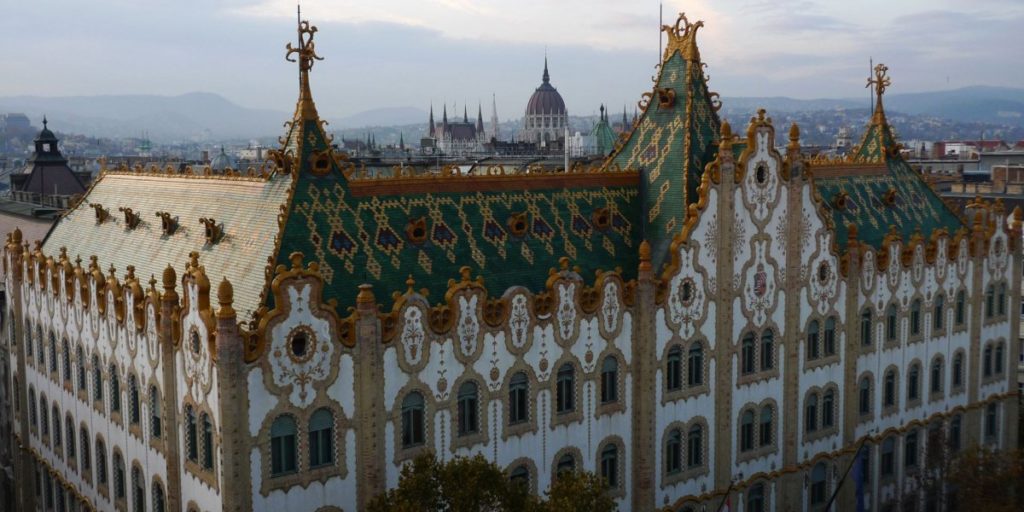
Architectural Significance and Design
Located just behind Liberty Square at 4 Hold Street, the Hungarian Postal Savings Bank (Postatakarékpénztár) stands as a masterpiece of Hungarian Art Nouveau architecture. Designed by Ödön Lechner and completed in 1901, the building showcases Lechner’s unique approach to blending national identity with the Art Nouveau movement. The façade is adorned with colorful ceramic tiles from the Zsolnay Porcelain Factory, featuring motifs inspired by Hungarian folk art, such as stylized floral patterns and bees—symbols of thrift and industry. The roof is particularly notable for its green-glazed tiles and decorative ceramic beehives, reinforcing the building’s thematic emphasis on savings and prosperity.
The building’s interior originally featured a grand glass dome that allowed natural light to illuminate the main hall, creating an inviting atmosphere for patrons. Although the dome was removed in the 1930s due to structural concerns, the interior still retains elements of its original design, reflecting Lechner’s vision of integrating functionality with artistic expression.
Historical Context and Legacy
Established in 1886, the Hungarian Postal Savings Bank aimed to promote savings among the general population by leveraging the extensive network of post offices across the country. This initiative provided accessible financial services to a broad segment of society, encouraging economic participation and financial literacy. By 1908, the bank had amassed over 684,000 depositors, highlighting its significant role in Hungary’s financial landscape.
The building served as the bank’s headquarters until 1948, when the institution was dissolved during the nationalization of Hungary’s banking sector. Subsequently, the building was repurposed and currently houses the Hungarian State Treasury. Despite changes in function, the structure remains a prominent example of early 20th-century Hungarian architecture and continues to attract interest for its artistic and historical value.
Today, the Hungarian Postal Savings Bank building stands as a testament to Ödön Lechner’s architectural legacy and Hungary’s cultural heritage. Its distinctive design and historical significance make it a notable landmark in Budapest, offering insight into the nation’s artistic movements and economic history.

Comments are closed.